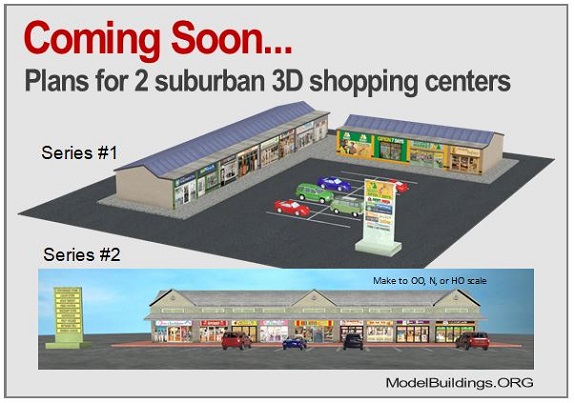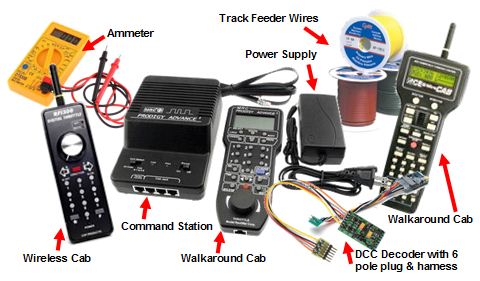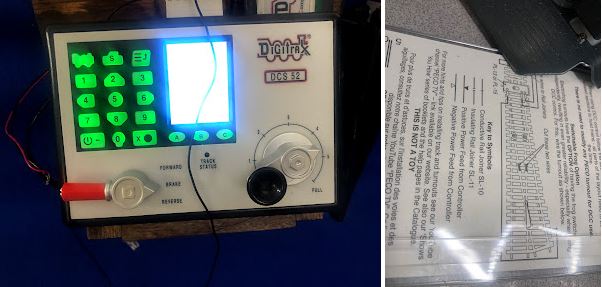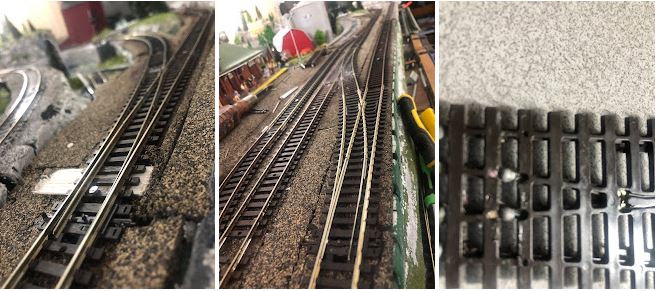Everything on model trains, model railroads, model railways, locomotives, model train layouts, scenery, wiring, DCC and more. Enjoy the world's best hobby... model railroading!
Track Voltage Loss
Neil models HO and asks:
“My loco drops 2 volts and slows the further away it gets from my power terminal track. Do I need 2 power terminal tracks positioned at opposite ends of my 9 foot track? Can someone clarify please?”
Get your question published on the blog too. See the link below.
NEW! Plans For 11 Scale Model 3D Shops Now Available To Download… Photo-Realistic!
CLICK THE VIDEO BELOW TO WATCH THE 2 Minute DEMO.
PDF plans for series #1 and series #2 are now available for download at https://www.modelbuildings.org/oo-n-ho-scale-3d-shopping-center-for-railroads
Code 100 Track Question
Beginner to the hobby Orjan asks:
“Sorry for my ignorance but in simple terms what does code 100 mean? If I go with code 100 would I always need to use the same track code?”
You can send in your own question for publication by using the ASK A QUESTION link below.
Gear Slipping on HO Scale Norfolk and Western Class J
David posted this:
“My sons love model trains but it is something I never messed with as a child. I am fully indulging their hobby looking for things on Craigslist and eBay. I just gave my son an HO Norfolk and Western 4-8-4 train I bought used off of eBay for his birthday. It ran around the track once perfectly, but then it started acting like the motor was not catching the gears properly. It runs but acts like a transmission slipping. I have repaired Thomas track master trains and a small HO Freedom Train but this train is larger and more complicated at least to me.
1) Is there a resource any of you would recommend for adjusting or replacing gears on such a model?
2)We live in Western North Carolina. Are there places I could take it for repair if it is beyond my scope and abilities? Thanks”
Ringling Bros and Barnum & Bailey Whistler
Bill writes:
“Dear Railroaders, I hope all are safe and well. I have a A.C. Gilbert Co., Ringling Bros and Barnum & Bailey Whistler, and believe it to be a Model 577. Running 3-rail O gauge trains. I have no wiring instructions or manual for the Whistler. Does anyone know where to access installation instructions, a parts list and/or wiring diagram? It would be greatly appreciated. Best regards.”
Submit your suggestions here.
Which EZ Track To Use
Darren who models HO asks:
“I’m using EZ track and am planning to add a two-stall engine shed to my layout. Which track should I use to have two lines run into the shed before combining just after exiting the shed? Will there be any likely issues?”
Post your comments below, or use the ASK A QUESTION link to have your own question published.
Which Industries To Model
Allan posted:
“I’ve decided on N scale for my new layout which has the potential to be 2ft-3ft deep in places in my 8ft x 10ft space. I also decided to model the late ’90s to the present day, but haven’t yet decided on an industry (industries) to incorporate. I had thought of logging & lumber, but there are probably better options these days. Ideas are definitely appreciated! Thanks in advance!”
You can contribute your suggestions below.
Planning a 3 Percent Track Grade
Simon asks:
“Looks a 3% grade section is what I’ll need on my 65″ x 90″ HO layout. I was hoping for less, but with 18″ curves and a 122″ run that’s what’s going to need to happen. My questions – How restrictive will 3% be? What do I need to watch out for?”
Add your suggestions to assist Simon below.
Model Paint Brands and Types – How They Compare
Gerrie writes:
“I don’t want to sound like a scrooge, but the price of model paints seem expensive ranging from $4, $5, $6 for tiny bottles/cans up to $12 or more for spray rattle cans. I want to repaint an old 4-6-0 I picked up on eBay so presume enamel would be best? Scenery/structures I am thinking acrylic? Spray, can, bottle… not sure which way to go? It seems like I could end up buying dozens of different paints. Is there any easy cheaper way? What do other people have?”
Have your say below… and, see what others say too.
Coming Soon… Plans For Two New Suburban Retail Shopping Centers
Soon to be released… plans for Series #1 and Series #2 suburban shopping centers (centres British English spelling).
Is DCC what you are looking for?
David K Thompson author of the DCC Help e-book contributed this article to share:
Is DCC what I am looking for?
The DCC layout has several advantages over the conventional DC railroad model, but the end decision on whether or not you should get it for your project depends upon your considerations and requirements.
At the end of the day, it is all about ease of use, functionality, and worth based on the money. So, make sure you keep the following points in mind before deciding upon DCC as your final choice for your personal railroad model!
- The Size of the Project – The magic of DCC is fully felt in large-size models – they do not need to have extensive accessories and a large number of branches and multi-tracks, but the larger-than-life experience is what makes DCC so functional and popular amongst hobbyists.
- Even if your layout is simple, a large layout with multiple trains running within the same control simultaneously is what is the main advantage of DCC. However, if you want a small layout with only a single person operating a single train, then DCC won’t do anything special for you.
- Go for DCC if you wish to control more than one train on the same layout at the same time!
- The Number of Users to Operate the Model – DCC gives you the functionality of adding multiple throttles that can be used by different users at the same time to control different trains. The throttles can also be walk-around or wireless, which makes the experience more fun and exciting. So, if you are looking for that kind of multi-user experience, DCC should be the top choice on your list!
- The Final Track work Setup – DCC operation does not require any extensive wiring skills, but it should be done with care and expertise to avoid any disruptions and short circuits. The track will have to be clean at all times, and free from any kinks and additional switching that can complicate things.
The existing wiring does not need to be changed much – just the BUS wires have attached feeders, which are then to be connected and soldered correctly to the track keeping the polarity in mind. Using different colored wires and a good wiring diagram will do the trick.
You do need to have any exceptional wiring skills – basic soldering and usage of wiring equipment will work just fine. So, if you are a beginner looking for minimum hassle and a straightforward wiring criterion, DCC will work great for you! - Cost and Budget Considerations – The DCC system may seem to be heavy on the pocket at the initial stages, because the investment in the decoders, the control station, and the boosters may seem to be pretty expensive.
However, rest assured, a sound investment done once on the system will keep you happy and occupied for several years to come and you do not need to spend on any additional maintenance as well if you take the necessary measures for short circuits. - Many inexpensive and cost-effective systems are easily available in the market. So, for the record, a DCC layout is well worth the money it comes for!
Golden Spike II with a Santa Fe Engine
Kayla writes:
“My son was just given an HO scale train set. It is a Golden Spike II with a Santa Fe engine on the box, but the model engine is a Burlington Northern. It is a 105 piece set. I am just interested in some information on the set. I tried searching, but I am a complete novice. Thank you in advance!”
Locomotive Losing Contact Along Track
Clint has HO and asks:
“I have a DCC layout. I purchased a used, but newer, (closed can motor) Walthers Trainline diesel. The track has been cleaned. All other locomotives run fine, but the Walthers hesitates and sometimes stalls. Are the wheels different on the Walthers? What is the fix?”
Peco Electro Frog turnouts With Circuitron SMAIL Switch Machines
Kim writes:
“I am working with Peco Electro Frog turnouts and I am using the Circuitron SMAIL switch machines but the electrical puzzle I am dealing with now has nothing to do with the motors. So this person from Iron Planet Hobbies says do not modify these so the jumpers underside are connected, There were connected out of the package and there is a frog wire. So in my photos I am showing first a single left turnout, currently directing the train to the curve so in that position switch is working fine. The other way I have set up as a switch throw and it goes into a spur by an elevator so what is happening, when I throw the switch and the blades move to other rails, it is causing a track fault.
So other photo is a crossover using two left turnouts. It is fine when they are in close (straight) but like the other one (#3), soon as I throw and blades contact other rails, FAULT. These switches are 2 A and B, I throw 1 A and B which is for a side and it does not fault. Other photos is a diagram and the underside showing the jumper.
I live in mpls/St Paul MN and wished a had an electrical expert here. Motors are working great, moving switches very nicely. I started in front to get this working right before going to the back to the same switch layout but without the single switch. In the link, there is a photo of my Digitrax Zephyr DCS52. If anyone out there are using these same type switches, I could use some advice cause I am not understanding this.”
Wiring for Susquehanna Valley & Gulf Summit
Jon B has been an N scale modeler since 1978 and posted this:
“Yours truly is in process of building the Susquehanna Valley & Gulf Summit N Scale layout. It first appeared in 1970 as ‘Nine Atlas N Scale Model Railroads’ as Layout N-109. There was a 2nd edition revised in August of 1976. Some years ago, a modeler published a DCC wiring version. Today, the same N scale layout is known as Atlas Layout N-18.
Drum roll, please…
My question is – Do any of you know where I can get a wiring schematic that will allow DCC on the Upper Level and DC with TWO DC controllers for the bottom level?
The rationale for this is yours truly wants to operate the upper level while two grandsons operate the DC version on the lower level.”
Please add your comment or suggestion below to assist Jon.
Athearn Genesis Challenger on 18 Inch Radius
Roland asks this question:
“I plan on buying a pre-loved (I presume that means 2nd hand but used with care) HO Athearn Genesis Challenger. Due to where it is, I will need to buy it untested. From the pictures and description, it does look to be in good condition, and the price seems fair considering what they go for new. My research tells me a 22-inch radius is recommended, but I only have 18-inches. Does anyone have any experience with running this model on less than a 22-inch radius, and what’s the general opinion on the Challenger?”
Post your question below, or post your comment below.
Thoughts on Atlas Code 83 Track
Wayne posted this question:
“It’s taken me a while, but I’m now at the point of buying track for my first HO layout which will be 9ftx4ft. My cousin uses Atlas code 83 track, but before committing I would like other people’s thoughts on what track would be best? Does it come down to personal preference, or is one track better than another?”
To have your question published use the ASK A QUESTION link below.


















